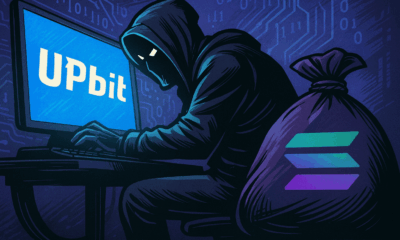News
Firedancer Devs Aim to Turbocharge Solana by Dropping the Block Limit

- Share
- Tweet /data/web/virtuals/383272/virtual/www/domains/theunhashed.com/wp-content/plugins/mvp-social-buttons/mvp-social-buttons.php on line 63
https://theunhashed.com/wp-content/uploads/2025/09/firemoto-1000x600.png&description=Firedancer Devs Aim to Turbocharge Solana by Dropping the Block Limit', 'pinterestShare', 'width=750,height=350'); return false;" title="Pin This Post">
In a bold move that could redefine Solana’s performance ceiling, developers behind Firedancer—a high-performance validator client led by Jump Crypto—have proposed removing Solana’s static block compute limit. The goal: unlock greater throughput, push the limits of validator performance, and turn Solana into an even faster, more scalable blockchain. But not everyone is convinced the gains will come without tradeoffs.
Breaking the Limit: A New Direction for Solana
Today, Solana enforces a fixed compute budget per block—60 million compute units (CUs), to be exact. That ceiling governs how much computational work validators can include in each block, essentially capping the number or complexity of transactions that can be processed.
Under a new proposal dubbed SIMD-0370, the Firedancer team suggests removing that hard limit entirely. Instead of imposing a universal ceiling, each validator would handle blocks according to their own hardware and software capacity. Validators capable of processing more would be free to do so. Those unable to keep up would simply skip the heavier blocks.
This approach transforms performance from a fixed constraint into a competitive differentiator. Faster validators can handle more transactions and, in turn, earn more fees. Slower nodes either catch up or fall behind. The hope is to create a “performance flywheel” where every validator is incentivized to upgrade their systems, accelerating the entire network’s capabilities.
The Firedancer Vision
Firedancer is a validator client built by Jump Crypto specifically to address throughput bottlenecks and reliability issues on Solana. Its creators envision a Solana ecosystem where network limits are no longer imposed by protocol-level constraints but are instead determined by validator innovation.
The removal of the compute unit ceiling aligns closely with Firedancer’s mission. With performance no longer throttled by artificial boundaries, validators running optimized clients like Firedancer could achieve significant speed advantages. The architecture would essentially allow the best-performing validators to set the pace for the rest of the network.
This vision comes as Solana prepares to roll out its next major upgrade, Alpenglow, which has already been approved. That upgrade introduces sweeping improvements to network latency, finality, and block propagation—making it an ideal foundation for more aggressive performance experiments.
A Double-Edged Sword: The Risk of Centralization
The proposal has sparked immediate debate within the Solana community. The promise of higher throughput is enticing, but critics argue it could exacerbate centralization.
Validators with access to high-end hardware or custom software could increasingly dominate the network, pricing out smaller or less-resourced operators. As more powerful validators win more block inclusion opportunities—and with them, more rewards—the validator set could become increasingly concentrated in the hands of a few.
This trend threatens one of Solana’s most important attributes: decentralization. A blockchain’s security and censorship resistance depend heavily on a wide, diverse set of validators. If too many drop out or fall behind, Solana risks trading decentralization for raw speed.
Some developers have cautioned that allowing block size to grow unchecked could create an uneven playing field, effectively forcing validators into an arms race of ever-more-expensive upgrades.
Timing Is Everything: The Alpenglow Milestone
SIMD-0370 is slated to follow closely behind the Alpenglow upgrade. Alpenglow introduces a host of improvements to Solana’s performance architecture, including significantly faster finality (from approximately 12.8 seconds to as low as 150 milliseconds), better block propagation, and enhanced failure recovery.
These upgrades make the network more robust and better equipped to handle dynamic block sizing. In that context, removing the block cap becomes a logical next step—an opportunity to build on Alpenglow’s foundations with even more aggressive throughput strategies.
The Road Ahead: Questions Without Easy Answers
As the proposal gains traction, several open questions remain. Will validators embrace the new structure, or push back against the added pressure to upgrade? Can the network avoid the centralization trap, or will performance optimization become a proxy for validator dominance?
There’s also the technical question of implementation. Moving from a fixed to a dynamic compute model will require robust fail-safes to prevent network instability. Transition strategies, grace periods, or tiered rollouts may be necessary to ensure smooth adoption.
Then there’s the user experience. Will end users actually see faster transaction confirmations, lower fees, or better reliability? And if validator diversity shrinks, will those gains come at the cost of the network’s long-term health?
A High-Stakes Experiment
Solana has long marketed itself as the fastest layer-1 blockchain, but speed alone is no longer a unique selling point. Competing chains are catching up, and user expectations continue to rise. To stay ahead, Solana needs bold ideas—and the Firedancer proposal is certainly that.
If it succeeds, removing the block limit could usher in a new era of scalable, adaptive blockchain performance. But if it accelerates centralization or introduces unforeseen complexities, it could destabilize the delicate balance that makes Solana work.
This is more than just a technical tweak—it’s a philosophical shift in how blockchains grow. Whether it proves visionary or risky will depend on how carefully it’s executed, and how well the community navigates the tradeoffs.
Ethereum
Small Kingdom, Big Move — Bhutan Stakes $970 K of ETH via Figment to Back National Blockchain Ambitions

Bhutan Turns Heads With Institutional‑Grade ETH Stake
The government of Bhutan quietly moved 320 ETH — worth roughly $970,000 — to Figment, the well-known staking provider, signaling a major shift in how the Himalayan kingdom engages with crypto. Rather than a speculative or retail‑style buy, this is an institutional‑level stake: the amount deployed corresponds to 10 full Ethereum validators (since each validator requires 32 ETH).
More Than Just Yield: Bhutan Anchors Crypto in Governance
Bhutan’s ETH stake comes on the heels of a far broader crypto‑adoption push. In October 2025 the country launched a sovereign national digital identity system — built not on a private chain, but on the public Ethereum blockchain. The decision to anchor citizen identities on a decentralized, globally supported network like Ethereum underscores a long‑term vision: decentralized identity, on‑chain transparency, and national infrastructure built with blockchain.
For Bhutan, this ETH stake isn’t about short‑term price swings or hype — it reflects a strategic bet on Proof‑of‑Stake infrastructure. By running validators via Figment, the government contributes to network security, potentially earns rewards, and aligns its own holdings and governance systems with the protocols underlying its digital‑ID rollout.
What This Signals for Ethereum — and for Crypto Governance
Though 320 ETH is a drop in the bucket compared to total staked ETH globally, the move carries symbolic weight. A sovereign state publicly committing funds to ETH staking via a recognized institutional provider adds to the broader narrative: that Proof‑of‑Stake networks are maturing, and that blockchain can underpin more than speculative assets — it can support identity, governance, and long-term infrastructure.
Moreover, it highlights that institutional staking services like Figment are increasingly trusted not only by hedge funds or corporations, but by governments. According to Figment’s own data, their Q3 2025 validator participation rate stood at 99.9%, and they reported zero slashing events — underlining the reliability such clients are counting on.
What to Watch Next
Will Bhutan stake more ETH? On‑chain data shows the wallet still holds a portion of ETH that remains unstaked — suggesting potential for future validator additions.
Will other nations follow suit? If Bhutan’s mixed use of crypto — combining reserve assets, public‑service infrastructure, and staking — proves viable, it could serve as a blueprint for other smaller states looking to modernize governance with blockchain.
Will this affect ETH’s valuation? Hard to say immediately. The 320 ETH is unlikely to move market prices by itself. But if this step becomes part of a larger trend toward institutional and sovereign staking, the cumulative effect on demand and network security could indirectly support ETH’s long-term value proposition.
Altcoins
Meme Coins Are Losing Their Mojo — From 20 % of Crypto Buzz to Just 2.5 % This Year

Meme‑Coin Hype Takes a Hard Hit
A recent report shows that collective interest in meme coins has plunged from about 20 % of all crypto chatter in late 2024 to roughly 2.5 % by October 2025 — a collapse of nearly 90 %. This shift reflects not only a drop in social buzz but also a broader retreat of speculative enthusiasm across the market. What once felt like the wild west of crypto — rapid launches, viral marketing and huge price swings — is cooling fast.
Market Metrics Confirm the Slide
The decline isn’t just anecdotal. Over the past year, more than 13 million meme tokens flooded the market, many with little to no utility — and most quickly vanished or failed. In a sector built on hype, many of these coins turned out to be short‑lived bets. Overall, the fully diluted market capitalization of memes has dropped by nearly 50 % year‑to‑date, according to blockchain analytics firms.
Trading volume has also cratered. In the first quarter of 2025, memecoin trading volume reportedly fell by 63 %. In many markets, memecoins’ share of overall trading volume dropped below 4 %, marking a dramatic retreat from their previous prominence.
What’s Driving the Decline
The collapse appears driven by a mix of oversaturation, weak fundamentals, and shifting investor preference. The meme‑coin ecosystem became overcrowded — tens of millions of projects launched, many with no clear roadmap or utility beyond chasing quick returns. That oversupply, combined with a broader crypto market slump, has wreaked havoc on liquidity and investor confidence.
Some analysts also cite growing regulatory scrutiny and a rising demand for real utility and transparency rather than hype‑driven “get‑rich‑quick” schemes. Meanwhile, capital and attention are rotating toward more tangible crypto sectors — such as AI‑powered tokens, infrastructure projects, DeFi, privacy coins and even traditional‑finance–style crypto instruments.
Could This Be a “Generational Bottom”?
Some within the community argue that the crash may bottom out soon — and that a new cycle could follow. Once the “dead weight” of unsustainable projects is cleared out, more serious, utility‑driven tokens could regain attention. Others believe the meme‑coin era may be effectively over — that the speculative mania has dissipated, and unless a meme coin brings real innovation or value, investors will avoid it.
Broader Implications for Crypto Markets
The downfall of meme coins underscores a broader maturation of the crypto industry in 2025. Markets appear to be shedding excess speculation and gravitating toward assets with fundamentals. This could lead to healthier ecosystem growth, better token design, and more sustainable long‑term investment — but also less room for high‑risk, high‑reward “moonshot” plays that defined crypto’s early years.
Altcoins
NYSE Arca Files to Launch Altcoin-Focused ETF

Fresh Rule‑Change Proposal Seeks Green Light From SEC
A fresh proposal filed by NYSE Arca could soon bring a new kind of cryptocurrency investment product to the U.S. market. In partnership with asset management giant T. Rowe Price, the exchange is seeking regulatory approval to list an actively managed crypto ETF that goes beyond Bitcoin and Ethereum. If approved, the fund would give investors exposure to a mix of top altcoins—like Solana, XRP, Cardano, and more—through a traditional stock exchange, eliminating the need for wallets, private keys, or crypto trading accounts.
What the Fund Would Do: A Broad, Actively‑Managed Crypto Basket
The Fund isn’t a passive single‑asset product but aims for active management. Its objective is to outperform the FTSE Crypto US Listed Index over the long term.
At launch the Fund intends to hold a diversified basket of “Eligible Assets,” which currently include major tokens such as Bitcoin (BTC), Ether (ETH), Solana (SOL), XRP, Cardano (ADA), Avalanche (AVAX), Litecoin (LTC), Polkadot (DOT), Dogecoin (DOGE), Hedera (HBAR), Bitcoin Cash (BCH), Chainlink (LINK), Stellar (XLM), and Shiba Inu (SHIB).
The Fund may hold as few as five, or as many as fifteen, crypto assets at any given time — and is not strictly tied to the index’s weighting. It may over‑ or underweight certain assets, or include crypto outside the index, guided by active selection criteria such as valuations, momentum and fundamental factors.
The idea is to give investors exposure to a diversified crypto portfolio without having to manage wallets, custody, and rebalancing — while potentially delivering better returns than a static, index‑tracking fund.
Risk Controls, Custody and Governance
To ensure safety and regulatory compliance, the Fund will store its crypto holdings with a dedicated crypto custodian. Private keys will be secured under strict controls, preventing unauthorized access or misuse.
When the Fund stakes any crypto (if staking is employed), it will maintain policies to ensure sufficient liquidity to meet redemptions, especially if a large portion of assets becomes illiquid or locked.
Valuation of the crypto holdings — used to compute Net Asset Value (NAV) per share — will rely on reference rates from third‑party price providers, aggregated across multiple platforms. The NAV will be computed daily, aligned with close of trading on the Exchange or 4:00 p.m. E.T.
Why It Matters for Crypto and Traditional Finance
This filing reflects a broader shift in traditional financial markets embracing diversified, regulated crypto investment vehicles. Unlike earlier spot‑crypto ETFs designed for single assets (e.g., Bitcoin), this Fund proposes a multi‑asset, actively managed basket — potentially appealing to institutional investors and diversified‑portfolio allocators seeking crypto exposure with traditional ETF convenience.
If approved, the Fund would offer a streamlined, compliance‑friendly bridge between traditional capital markets and crypto assets, lowering operational friction for investors who prefer not to deal with wallets, exchanges, or self‑custody.
The approach may also set a precedent: showing that active crypto ETFs can meet listing standards under rules originally written for commodity‑based trusts. This could open the door for more innovation — perhaps funds targeting niche themes (smart‑contract tokens, layer‑2s, tokenized real‑assets) while still abiding by exchange and regulatory requirements.
What’s Next
The SEC review period typically spans up to 45 days from publication (or longer if extended), during which comments from market participants and the public may shape the final decision.
If approved, it may take some additional time before shares begin trading — during which documents like the fund’s prospectus, ETF symbol, and listing date will be finalized and disclosed by the sponsor.
-

 Cardano2 months ago
Cardano2 months agoCardano Breaks Ground in India: Trivolve Tech Launches Blockchain Forensic System on Mainnet
-

 Cardano2 months ago
Cardano2 months agoCardano Reboots: What the Foundation’s New Roadmap Means for the Blockchain Race
-

 Cardano2 days ago
Cardano2 days agoSolana co‑founder publicly backs Cardano — signaling rare cross‑chain respect after 2025 chain‑split recovery
-

 Bitcoin2 months ago
Bitcoin2 months agoQuantum Timebomb: Is Bitcoin’s Foundation About to Crack?
-

 Cardano2 months ago
Cardano2 months agoAfter the Smoke Clears: Cardano, Vouchers, and the Vindication of Charles Hoskinson
-

 Cardano2 months ago
Cardano2 months agoMidnight and Google Cloud Join Forces to Power Privacy‑First Blockchain Infrastructure
-

 Ripple2 months ago
Ripple2 months agoRipple CTO David “JoelKatz” Schwartz to Step Down by Year’s End, but Will Remain on Board
-

 News2 months ago
News2 months agoRipple’s DeFi Awakening: How mXRP Is Redefining the Role of XRP








